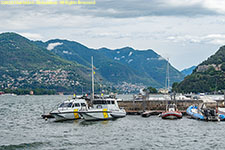
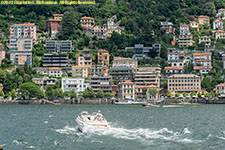
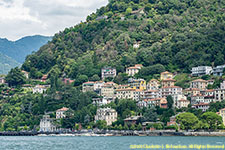
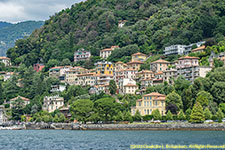
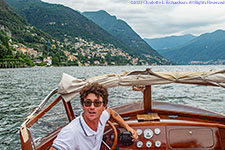
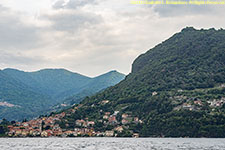
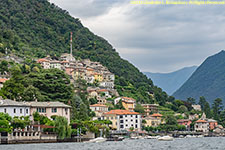
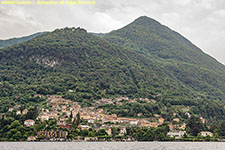
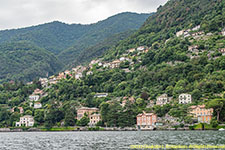
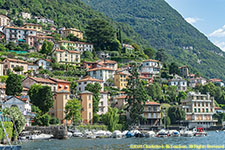
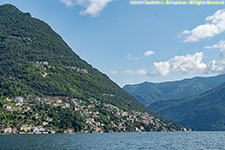
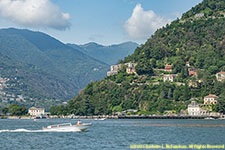
Lombardy, in north-central Italy, is home to more than a sixth of Italy's population. The region is located between the Alps and the tributaries of the Po River. Lombardy's numerous lakes are of glacial origin and all are located in the northern highlands. Lombardy is an important center for silk and textile production.
Como lies at the southwestern tip of Lake Como.
The city was founded by the Romans in 196 BCE.
The Romanesque Porte Torre fortified tower is 40m high and was built in 1192 to defind the main entrance to the city from the south.
The Gothic Duomo, begun in 1396 but not completed until 1770, is dominated by Filippo Juvarra's Baroque dome. The sculpture on the Gothic facade and Porta della Ranab door were executed by Tommaso and Jacopo Rodari around 1500. The nave and side altars are decorated with 16th-century tapestries and canvases by Ferrari and Luini.
There are many other Romanesque churches.
Como is famous for its lakeside villas...
... and for the Tempio Voltiano built in 1928 memorializing Como native Alessandro Volta and his work with gas and thermal phenomena, electrology and electrometry, electrical phenomena and electrical metereology.
Many streets, plazas, statues, and ships are named after Volta. The "Life Electric" sculpture at the end of a pier in the lake, completed in 2015, is also dedicated to him.
A funicular, built in 1894, connects Como to Brunate, 1600' above.
Food is always an imporant part of a visit. We sampled local wines, cheeses, sliced meats, olive oils, and gelato,...
... and took a water taxi to Moltrasio for a romantic dinner at the Imperialino.
Como is home to the oldest seaplane operation in the world, Aero Club Como. I had hoped to fly with them but got weathered out several times due to thunderstorms and high winds.
Milan (Milano) is the largest metropolitan area in Italy and the second most populous city in Italy after Rome with a population of 1.4 million. It is a capital of fashion. Milan is in the northwest Po Valley. The concentric layout of the city center reflects the Navigli, an ancient system of navigable interconnected canals, now mostly covered. There are few remains of the ancient Roman colony, notably the well-preserved Colonne di San Lorenzo. We happened to be visiting Milan on a Monday, when most of the museums are closed.
The Galleria Vittorio Emanuele II was one of the first iron and glass constructions in Italy, built in 1865, a 19th century shopping mall.
Milan's Lombard-Gothic cathedral (Duomo di Milano), built between 1386 and 1877, is the fifth largest cathedral in the world. Final details were only completed in 1965.
The oldest roof spire dates from 1404.
On top is the Madonnina, the symbol of Milan. It was erected in 1762 at 108.5m. By tradition no building in Milan is taller than the Madonnina, so as taller buildings were built replicas of the statue were placed atop them.
Most of the stained-glass windows date from the 19th century. The oldest one dates to 1470-75 and the newest one from 1988.
The Piazza Mercanti (Merchants' Square) is fronted by the Baroque Palazzo delle Scuole Palatine, built in the 17th century as a prestigious school of higher education. The Gothic building to the right is Casa Panigarola (Palazzo del Notai, meaning "Notary's Palace"), built in the 18th century.
The Loggia Degli Osii was built in 1316 as an administrative seat.
The Pinacoteca di Brera, built in 1627-28, is the main public gallery of paintings in Milan, containing one of the main collections of Italian paintings from the 13th to the 20th century. The sculpture in the courtyard is a bronze cast of the marble statue by Antonio Canova of Napoleon as Mars the Peacemaker.
The Church of Santa Maria de Carmine was built in 1339-1400 and completed in 1446. In the 17th century the presbytery was restored in the Baroque style. The facade was built in 1880 in the Neo-Gothic style.
Castello Sforzesco (Sforza's Castle) is a medieval fortification built in the 15th century by Francesco Sforza, Duke of Milano, on the remains of a 14th-century fortification built by the Visconti, and later renovated and enlarged in the 16th and 17th centuries, one of the largest citadels in Europe. The central tower is Torre del Filarete, named for the scultor and architect Filarete. it collapsed in 1521 when the gunpowder kept there exploded, and was rebuilt in 1905 working from the original drawings.
The second century Roman ruins of the Palazzo Imperiale di Massimiano were built in 257-259 to provide Emperor Maximianus a palace to administer the Western Roman Empire. The entire palace was heated. A hippodrome (circus) adjoined the palace.
The Gorani house is the remaining Baroque portal of a palace destroyed by bombing in 1943. It is the only surviving Middle Ages tower in Milan.
The Basilica of Saint'Ambrogio is one of Milan's oldest churches, commissioned by St. Ambrose in 379-386. Built in an area where numerous martyrs of the Roman persecutions were buried, it was first named Basilica Martyrum. Its current Romanesque appearance began around 1080. Two separate religious communities shared the basilica, symbolized by its two towers. The 9th century Torre dei Monaci (Tower of the Monks) was used by the Monks to call the faithful to prayer. The Canons did not have a bell tower and were not allowed to ring bells until they finished their own, taller, tower in the 12th century. The 9th-century altar is gold. Nine kings of Italy were crowned here, from the 9th to the 15th century, and four are buried here. Considerable restoration was needed after WW II.
The Basilica di San Lorenzo Maggiore is also one of the oldest churches in Milan, originally built in Roman times but rebuilt several times over the centuries. At the time of its construction in the 4th to 5th century it was the largest centrally-planned building in the West. It was built on an artifical hill near the main access route to the city. Some of the stone blocks used to built it came from the Imperial Palace and the ampitheater, still visible underneath the current structure where they were used to compact the soil. The basilica consists of a main domed section linked to a series of minor buildings dating from different periods.
The 16 Roman Colonne di San Lorenzo (Corinthian columns) across the square facing the basilica are one of the few remains of the Roman Mediolunum, dating from the 3rd century and probably originally belonging to the large baths built by Emperor Maximian or to a pagan temple, moved to their current location when the basilica was finished in the 4th century.
The medieval Gothic-style Porta Ticinese is a gate of the former 12th century walls of Milan, one of three remaining medieval gates, the others being Porta Nuova and the Pusteria di Sant'Ambrogio. The gate originally stood on the inner side of a navigable moat (cerchio del navigli) that ringed the city. The new decorative gate was built in 1801-1814.
The Basilica of Sant'Eustorgio was probably founded in the 4th century and is said to contain the tomb of the Three Magi. It was rebuilt in the Romanesque style in the 12th century. It is the main Milanese seat of the Dominican order. In memory of the Three Magi the bell tower is surmounted by a star instead of the traditional cross. The interior of the church is filled with Renaissance frescoes.
The Navigli are a system of interconnected canals in and around the city dating back to the Middle Ages. There are five canals, three connected to an inner ring. Leonardo da Vinci designed the locks and dams on the canals, allowing navigation from Lake Maggiore to the center of Milan to bring marble from Candoglia for the construction of the cathedral. Today the canals are mostly used for irrigation. The Navigli area of Milan is an artists' quarter with many restaurants, boutiques, and bars.
©2023 Mermaid Underwater Photographic. All Rights Reserved.
This page sponsored by Mermaid Underwater Photographic. Contact us at mermaid@underwater.org.
Last modified 17 August 2023